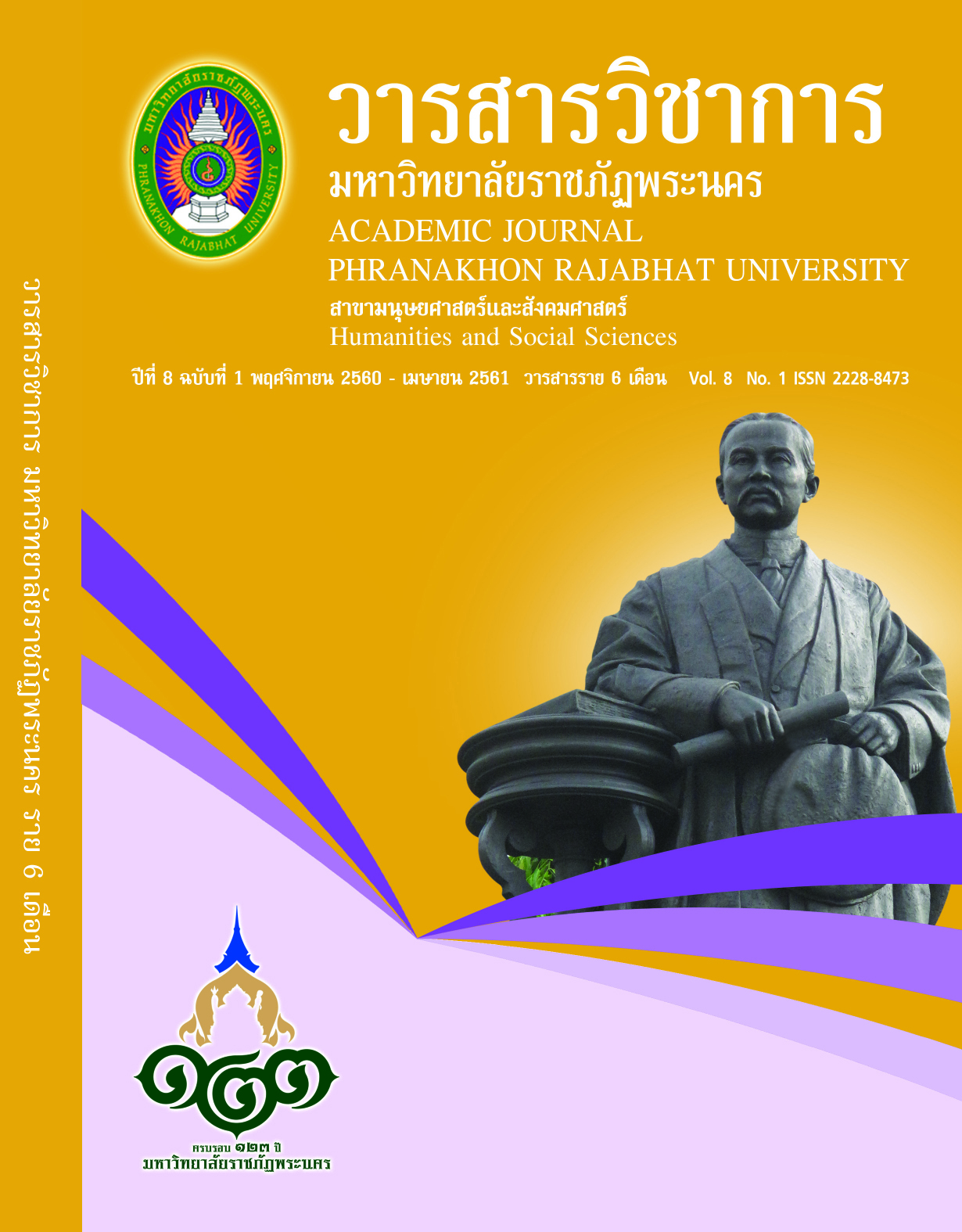Guidelines for Drugs Prevention Problems for Youth in Chachoengsao Province
คำสำคัญ:
แนวทางป้องกัน, ปัญหายาเสพติด, เยาวชนบทคัดย่อ
การวิจัยมีวัตถุประสงค์เพื่อศึกษา 1) สภาพปัจจุบันปัญหายาเสพติดของเยาวชน 2) หาความสัมพันธ์ระหว่างปัจจัยที่มีอิทธิพลต่อการติดยาเสพติดของเยาวชน และ 3) กำหนดแนวทางการป้องกันปัญหายาเสพติดของเยาวชน ในจังหวัดฉะเชิงเทรา เป็นการวิจัยเชิงปริมาณและเชิงคุณภาพ กลุ่มตัวอย่างที่ใช้ในการวิจัย คือ เด็กและเยาวชน ในจังหวัดฉะเชิงเทรา จำนวน 400 คน ส่วนการวิจัยเชิงคุณภาพ กลุ่มตัวอย่างคือ ผู้เกี่ยวข้องกับการป้องกันยาเสพติดในจังหวัดฉะเชิงเทรา จำนวน 35 คน สถิติที่ใช้ในการวิเคราะห์ข้อมูลคือ สถิติพรรณนา ร้อยละ ค่าเฉลี่ย และค่าเบี่ยงเบนมาตรฐาน
ผลการวิจัย พบว่า 1) ปัญหายาเสพติดของเยาวชนในจังหวัดฉะเชิงเทรามีปัจจัยด้านการดูแลที่มีต่อเด็กและเยาวชน มีค่าเฉลี่ยอยู่ในระดับมาก 2) ส่วนความสัมพันธ์ระหว่างปัจจัยที่มีอิทธิพลต่อการติดยาเสพติดของเยาวชน ได้แก่ ปัจจัยด้านการดูแล ค่าเฉลี่ยอยู่ในระดับมาก รองลงมาคือ ปัจจัยด้านพื้นฐานครอบครัว โดยมีค่าเฉลี่ย 2.86 และ 2.60 ตามลำดับ ปัจจัยด้านสถานการณ์แวดล้อม มีค่าเฉลี่ยอยู่ในระดับปานกลาง โดยมีค่าเฉลี่ย 2.50 และ 2.21 เมื่อทำการตรวจสอบการกระจายของข้อมูลด้วยการพิจารณาค่าเบี่ยงเบนมาตรฐานในปัจจัยทั้ง 5 ด้าน พบว่ามีค่าอยู่ระหว่าง 0.72-0.99 ซึ่งมีค่าต่ำกว่า 1.00 แสดงให้เห็นว่าข้อมูลมีการกระจายตัวอยู่ในระดับมาก 3) สำหรับแนวทางป้องกันปัญหายาเสพติดของเยาวชน ได้แก่ มีแนวทางการพัฒนาทักษะชีวิตให้กับเยาวชน ให้อยู่ในสถานการณ์แวดล้อมที่ไม่พึงประสงค์อย่างปลอดภัย สามารถเอาตัวรอด ไม่ตกเป็นทาสยาเสพติด และจังหวัดฉะเชิงเทรากำหนดนโยบายความร่วมมือกับองค์กรที่เกี่ยวข้องทุกภาคส่วน ป้องกันยาเสพติดของเยาวชน โดยใช้ หลัก 3 จ 1 ป คือ จริงจัง จริงใจ จับจ้อง ป้องปราม และ 2 ต คือ ติดตามอย่างต่อเนื่องเพื่อสร้างความปลอดภัยให้กับเด็กและเยาวชนในจังหวัดฉะเชิงเทราได้อย่างยั่งยืน
เอกสารอ้างอิง
จิราพร สวัสดิรักษ์. (2555). นวัตกรรมการจัดการในการป้องกัน แก้ไขปัญหายาเสพติดของนักเรียนระดับมัธยมศึกษาในจังหวัดนนทบุรี. ปริญญานิพนธ์ปรัชญาดุษฎีบัณฑิต, มหาวิทยาลัย ราชภัฏสวนสุนันทา.
แผนปฏิบัติราชการจังหวัดฉะเชิงเทรา. (2559). แผนปฏิบัติราชการจังหวัดฉะเชิงเทรา ประจำปีงบประมาณ 2559 ค้นเมื่อ 18 กุมภาพันธ์ 2559, จาก http://www.website. chachoengsao.go.th
มณี ลิ้มปะวงศ์. (2553). ปัจจัยที่ส่งผลต่อการนำนโยบายป้องกันและแก้ไขปัญหายาเสพติดไปปฏิบัติ :
ศึกษากรณีศูนย์ฝึกและอบรมเด็กและเยาวชน เขต 5 จังหวัดอุบลราชธานี (รายงานผลการวิจัย). คณะรัฐศาสตร์ มหาวิทยาลัยอุบลราชธานี.
รายงานการประชุมประจำเดือน. (2559). รายงานการประชุมประจำเดือน หัวหน้าส่วนราชการจังหวัดฉะเชิงเทรา ครั้งที่ 8/2559 วันอังคารที่ 30 สิงหาคม 2559 ณ ศาลากลางจังหวัดฉะเชิงเทรา. ค้นเมื่อ 8 กันยายน 2559, จาก http://123.242.176.9/ccs/images/file_links/ workseet_8.pdf
รายงานวิเคราะห์สถานการณ์จังหวัดฉะเชิงเทรา. (2556). ค้นเมื่อ 18 กุมภาพันธ์ 2559, จาก http://osthailand.nic.go.th/
ศูนย์อำนวยการป้องกันและปราบปรามยาเสพติดจังหวัดฉะเชิงเทรา. (2559). รายงานการประชุมศูนย์อำนวยการป้องกันและปราบปรามยาเสพติดจังหวัดฉะเชิงเทรา ครั้งที่ 9/2559. ค้นเมื่อ 10 ตุลาคม 2559, จาก http://123.242.176.9/ccs/images/file_links/ workseet_9.pdf
สุวาพร เสภาศีราภรณ์. (2559). โครงการประชาสัมพันธ์ป้องกันและแก้ไขปัญหายาเสพติด ฉบับที่ 60/2559. ค้นเมื่อ 12 มิถุนายน 2559, จาก http://region1.prd.go.th/ewt_news. php?nid=42766
สำนักยุทธศาสตร์ สำนักงาน ปปส. (2559). กรอบแผนปฏิบัติการและแก้ไขปัญหายาเสพติด ปี 2559. ค้นเมื่อ 18 กุมภาพันธ์ 2559, จาก http://www.ppb.moi.go.th
Ashley Nicole Fricks - Gleason. (2010). Neural Substrates Underlying The Effects of Catecholamines on Cocaine –Cue Memories. Dissertation Submitted in partial Satisfaction of the Requirements for the degree of Doctor of Philosophy in Biological Sciences University of California, Irvine.
D’Amico, E. J., & McCarthy, D. M. (2006). Escalation and initiation of younger adolescents’
substance use. The impact of perceived peer use. Journal of Adolescent Health,
, 481-487Donovan, J. E. (2007). Really underage drinkers: The epidemiology of
children’s alcohol use in the United States. Prevention Science, 8, 192-205.
Edwards & Lopez, Edwards, L. M., & Lopez, S. J. (2006). Perceived family support,
acculturation, and life satisfaction in Mexican American youth: A mixed-methods
exploration. Journal of Counseling Psychology, 53(3), 279–287.
Ellickson, P. L., D'Amico, E., Collins, R., & Klein, D. (2005). Marijuana use and later
problems: When frequency of recent use explains age of initiation effects
(and when it does not). Substance Use and Misuse, 40, 343-359.
Johnston, L. D., O’Malley, P. M., Bachman, J. G., & Schulenberg, J. E. (2006). Teen drug use
continues down in 2006, particularly among older teens; but use of
prescription-type drugs remains high. University of Michigan News and Information Services: Ann Arbor, (Villar, Luengo, Gomez-Fraguela, & Romero, 2006)
Monica Hernandez. (2009). Examining Family Factors and Acculturation Issues
Contributing to Adolescent Substance Abuse in a Mexican American
Population. Dissertation Submitted in Partial Fulfillment of the Requirements for
the Degree of Doctor of Philosophy Psychology Walden University.
Stephanie Y vonne Smith, MPH. (2005). Nicotine Product Harm Perception and
Psychosocial Correlates of Use in Coliege Freshman. A Dissertation Submitted
to the Johns Hopkins University in Conformity with the Requirements for
the degree of Doctor of Philosophy.
Zucker, R. A., Donovan, J. E., Masten, A. S., Mattson, M. E., & Moss, H. B. (2008). Early
developmental processes and the continuity of risk for underage drinking and
problem drinking. Pediatrics, 121, S252-S272.
ดาวน์โหลด
เผยแพร่แล้ว
รูปแบบการอ้างอิง
ฉบับ
ประเภทบทความ
สัญญาอนุญาต
"บทความวิชาการในวารสารฉบับนี้ ถือเป็นความรับผิดชอบของผู้เขียนเท่านั้น"
สงวนลิขสิทธิ์ตามพระราชบัญญัติลิขสิทธิ์




